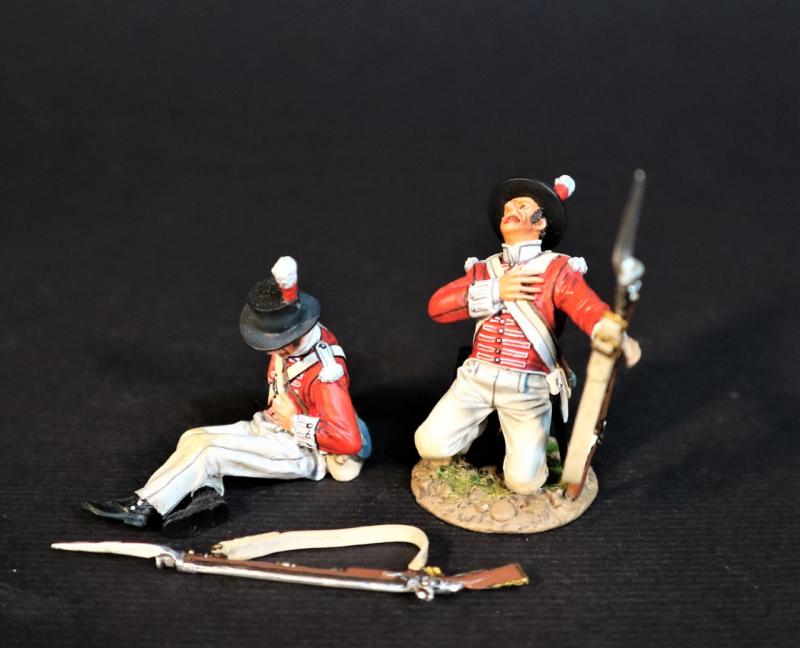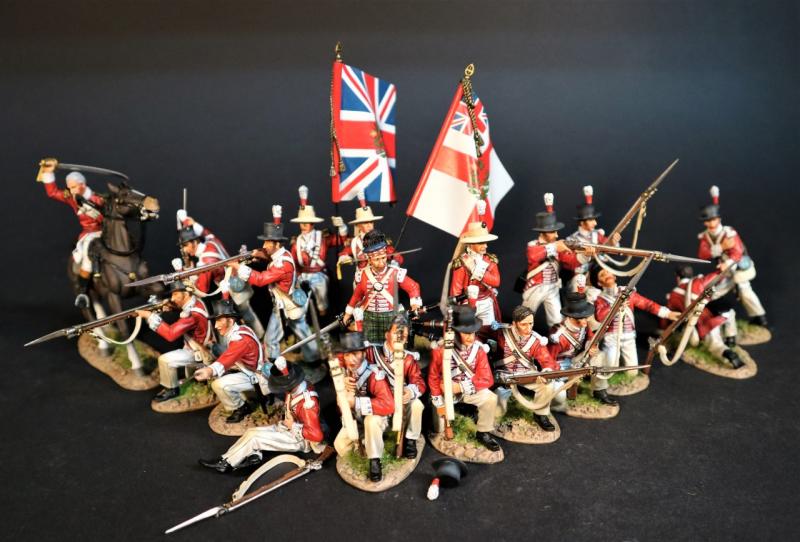Two Line Infantry (kneeling wounded, seated wounded), The 74th (Highland) Regiment of Foot, Wellington in India, The Battle of Assaye, 1803--two figures
$90.00
Item Number: WIN74-12
Two Line Infantry (kneeling wounded, seated wounded), The 74th (Highland) Regiment of Foot, Wellington in India, The Battle of Assaye, 1803
THE 74th (HIGHLAND) REGIMENT OF FOOT
The regiment was raised in Glasgow by Major-General Sir Archibald Campbell for service in India in October 1787. In accordance with the Declaratory Act 1788, the cost of raising the regiment was recharged to the East India Company on the basis that the act required that expenses “should be defrayed out of the revenues” arising there.
The regiment embarked for India in February 1789 and took part in the Siege of Bangalore in February 1791 and the Siege of Seringapatam in February 1792 during the Third Anglo-Mysore War.
At the Battle of Assaye in 1803, casualties were so high, every officer in the regiment was killed or wounded and what was left of the unit had to be led out of action by its regimental sergeant major. From an initial strength of about 500, the 74th lost ten officers killed and seven wounded, and 124 other ranks killed and 270 wounded.
The predominant arm in India was the infantry. The King’s and EIC native battalions were organized on similar lines, with the only difference being that the EIC battalions had two Grenadier companies and no light company, as it was believed that the native Indian soldier was considered a poor skirmisher.
The 74th (Highland) Regiment of Foot wore kilts and plaids of Government tartan from the time they were raised in 1787. However, they were soon ordered to India, where the regiment spent 18 years. On arrival at Madras, the kilt was discontinued as unsuitable. In 1803 the soldiers wore linen white trousers and black round hats.
Captain A. B. Campbell of the 74th, who had on a former occasion lost an arm, was seen in the thickest of the action with his bridle in his teeth and a sword in his right hand, “dealing destruction around him”. He was to survive the battle, although “one of the enemy in the charge very nearly transfixed him with the bayonet, which actually pierced his saddle”.
Wellesley’s infantry formed up in two lines on the far bank, with the British regiments on the outside flanks, the 74th opposite Assaye, the 10th Madras Native Infantry in the centre of the first line and the 4th and 12th Madras Native Infantry in the second. The 19th Light Dragoons and the 3 Madras cavalry regiments formed the reserve. The Mysore cavalry remained on the near bank of the Kaitna.
During the Battle of Assaye in 1803, Wellesley’s right flank was in turmoil. The commander of the right flank, Lieutenant Colonel William Orrock, had mistaken his orders and continued on an oblique path directly towards Assaye. The 74th under command of Major Samuel Swinton had moved so far north, it created a large gap in the centre of the British line, and brought the units on the flank under a barrage of cannonade from the artillery around the village and the Maratha left. The two battalions began to fall back in disarray, and Pohlmann ordered his infantry and cavalry forward to attack. The Maratha cavalry virtually annihilated the pickets, but the remnants of the 74th were able to form a rough square.
Realising the destruction of his right flank would leave his army exposed and outflanked, Wellesley ordered a detachment of British cavalry under Colonel Patrick Maxwell, consisting of the 19th Light Dragoons and elements of the 4th and 5th Madras Native cavalry into action. The cavalry dashed directly towards the 74th’s square, crashed into the swarming Maratha cavalry and routed them.
The regiment remained on home service until 1810, when it was sent to the Peninsular War (1808-1814) for four years. It fought at Busaco in 1810, Fuentes de Onoro in 1811, Ciudad Rodrigo, Badajoz, Salamanca in 1812, Vitoria, Nivelle, Orthes, and Toulouse. The Regiment saw service in Ireland at the time of Waterloo in 1815, and spent most of the following three decades in Canada and the West Indies.
In 1851, it arrived in the Cape Colony (in what is now South Africa) for the Eighth Cape Frontier War(1850-1853)
The troopship “Birkenhead” foundered off the coast of Southern Africa, the largest draft of new troops on board was intended for the 74th foot. Their discipline on deck as the vessel sank, later known as the “Birkenhead Drill”, allowed the women and children on board to be saved.
The Regiment was to return to India in 1854, remaining there for ten years and fighting in the Indian Mutiny (1857-59)
Due to be released in APRIL 2023.

